Geum L. (Rosaceae)
Geum (including taxa sometimes placed in Waldsteinia) is represented by ten species in North Carolina, half of which are listed (E&T) or of conservation concern. The federally listed species is Geum radiatum (Fed E). State listed species are G. aleppicum (State E), G. geniculatum (State SC-V), G. laciniatum (State E), and G. lobatum (State E). Note that, as for Liatris and Spiraea, the majority of rare taxa are found in the Piedmont and mountains.
Federally listed taxon—
Geum radiatum (Fed E, State E | S2 G2)
Habitat. High-elevation outcrops, steep rocky slopes, gravelly soils of summit balds.
Range. Endemic to the Southern Appalachians (W NC [S2] and E TN [S1]).
Additional resources. NHP | Recovery plan | 5-yr review
Key to Geum in North Carolina
Key adapted from Weakley (2008). Photos by Krings, unless otherwise indicated. Line drawings from Britton & Brown (1913), except G. laciniatum and G. lobatum (from Patrick et al. 1995). Maps courtesy of USDA PLANTS and the North Carolina Natural Heritage Program.
1. Style deciduous; hypanthium obconical; epicalyx absent or deciduous[note: present in Duchesnea, Fragaria, and Potentilla]...2.
2. Leaves trilobed...G. lobatum 
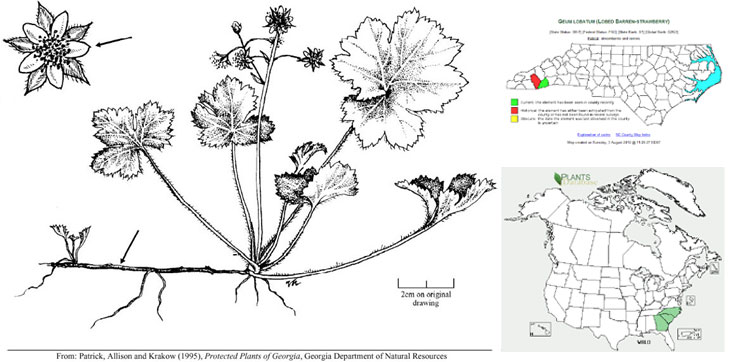

Habit of Geum lobatum (Photo: Krings)

Leaf of Geum lobatum (Photo: Krings)

Leaf of Geum lobatum (Photo: Krings)

Petiole vestiture of Geum lobatum (Photo: Krings)

Inflorescence of Geum lobatum (Photo: Krings)

Calyx of Geum lobatum. Note lack of epicalyx, as typical for the Waldsteinia group in North Carolina (Photo: Krings)

Flower of Geum lobatum (Photo: Krings)
Geum lobatum (rare [State E, S1 G3]; forests and streambanks; Mt)
2'. Leaves trifoliolate...3.
3. Petals 4–10 mm x 2–6 mm (longer than the sepals)...G. fragarioides 
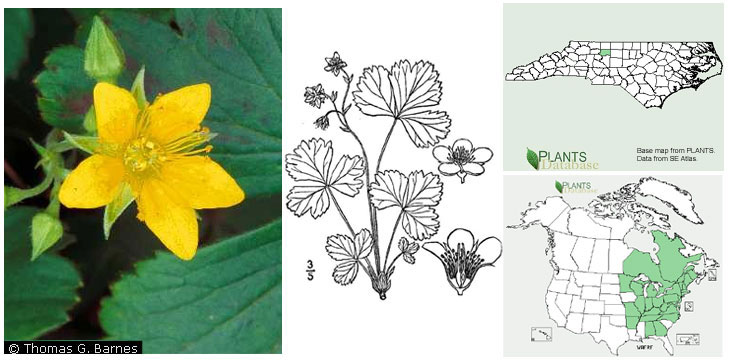 Geum fragarioides
Geum fragarioides (rare; forests and streambanks; Pd)
3'. Petals 2.5–4 mm x 1–1.5 mm (about as long as the sepals)...G. donianum 
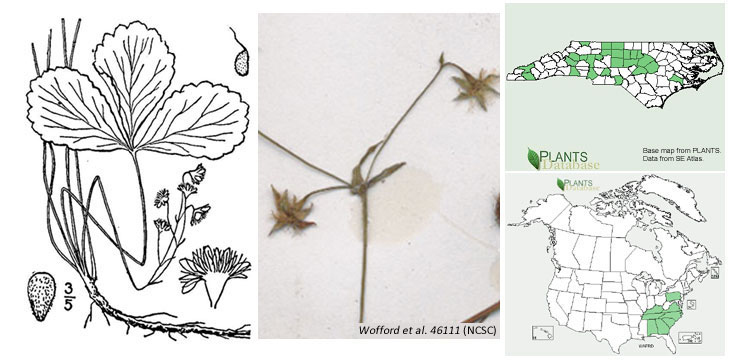

Habit of Geum donianum (Photo: M. Conlin)

Leaf of Geum donianum (Photo: M. Conlin)

Leaf of Geum donianum (Photo: M. Conlin)

Inflorescence of Geum donianum (Photo: M. Conlin)

Inflorescence of Geum donianum (Photo: M. Conlin)

Flowers of Geum donianum (Photo: M. Conlin)

Flower of Geum donianum (Photo: M. Conlin)
Geum donianum (uncommon: Pd; rare: Mt, CP; forests and streambanks; Mt, Pd, CP)
1'. Style persistent; hypanthium saucer- or cup-shaped; epicalyx present, except absent in G. vernum...4.
4. Style straight...G. radiatum* 


Geum radiatum habitat (Photo: Krings)

Simple leaves of Geum radiatum (Photo: Krings)

Simple leaves of Geum radiatum (Photo: Krings)

Stem of Geum radiatum (Photo: Krings)

Stem of Geum radiatum (Photo: Krings)

Calyx and flower of Geum radiatum (Photo: Krings)

Flower with straight styles, Geum radiatum (Photo: Krings)
Geum radiatum*
(rare [Fed E, S2 G2]; crevices and ledges of high elevation cliffs; Mt; summer to fall)
4'. Style with a kink or twist...5.
5. Calyx lacking bractlets between lobes; fruiting stipes 3–7 mm long, well exserted...G. vernum 
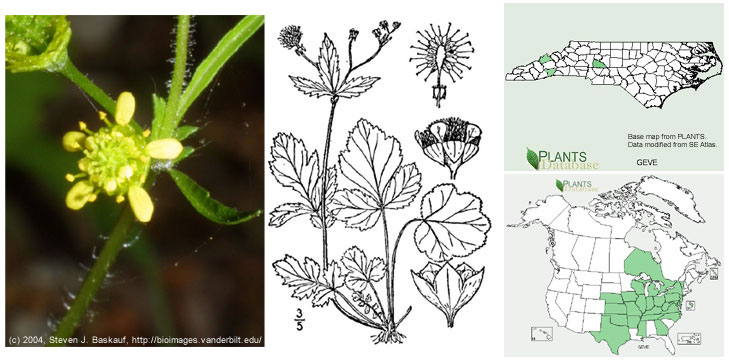

Geum vernum habit (Photo: S.J. Baskauf CC NC-SA 3.0,
Biomages)

Geum vernum habit (Photo: S.J. Baskauf CC NC-SA 3.0,
Biomages)

Stem of
Geum vernum (Photo: S.J. Baskauf CC NC-SA 3.0,
Biomages)

Leaf of
Geum vernum (Photo: S.J. Baskauf CC NC-SA 3.0,
Biomages)

Flowers of
Geum vernum (Photo: S.J. Baskauf CC NC-SA 3.0,
Biomages)

Flowers of
Geum vernum (Photo: S.J. Baskauf CC NC-SA 3.0,
Biomages)

Achenes of
Geum vernum; note subtending stipe (Photo: S.J. Baskauf CC NC-SA 3.0,
Biomages)
(uncommon; seepages, swamps, roadsides, disturbed areas; Mt, Pd)
5.' Calyx with bractlets between lobes; fruiting stipes < 3 mm, frequently obscured...6.
6. Portion of the style above the kink usually 4–7 mm long; flowers nodding, sepals green suffused with purple, erect to erect-spreading, petals erect or erect-spreading...G. geniculatum 
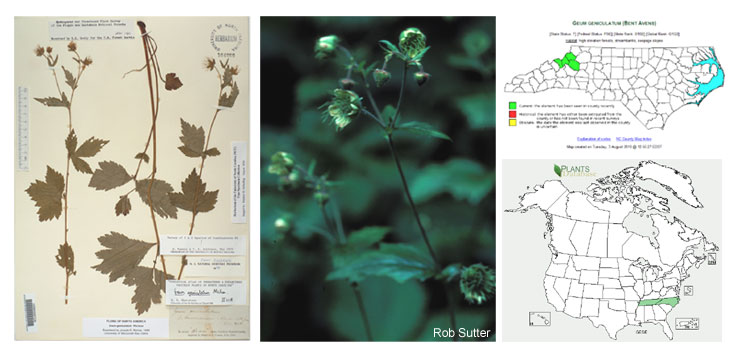

Habit of Geum geniculatum (Photo: Krings)

Leaf of Geum geniculatum (Photo: Krings)

Stipule of Geum geniculatum (Photo: Krings)

Flower of Geum geniculatum (Photo: Krings)

Flower of Geum geniculatum (Photo: Krings)

Achenes of Geum geniculatum (Photo: Krings)

Achenes of Geum geniculatum; note the long, straight portion of the style beyond the kink (Photo: Krings)
Geum geniculatum (rare [State SC-V, S1S2 G2]; seeps, cliff bases, grassy balds at moderate to high elevations; Mt)
6'. Portion of the style above the kink usually 1–2 mm long; flowers erect, sepals green, spreading to reflexed, petals reflexed...7.
7. Petals cream; fruiting tori bristly; larger stipules > 10 mm wide, coarsely toothed or even lobed... G. virginianum 
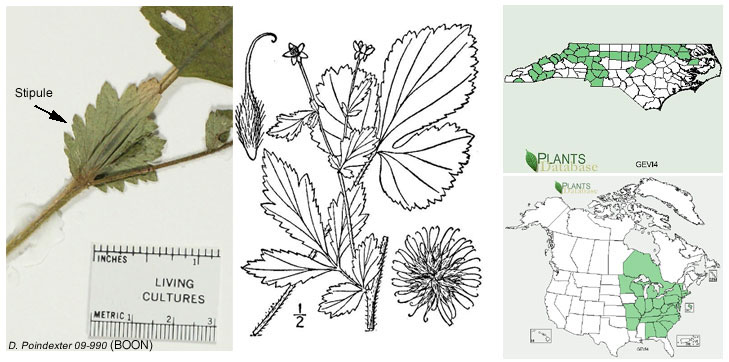

Leaf of Geum virginianum (Photo: Krings)

Stipule of Geum virginianum (Photo: Krings)

Stipule of Geum virginianum (Photo: Krings)

Stipules of Geum virginianum (Photo: Krings)

Flower of Geum virginianum (Photo: Krings)

Achenes of Geum virginianum; note also the short linear epicalyx lobes, in between the broadly triangular calyx lobes (Photo: Krings)

Achenes of Geum virginianum (Photo: Krings)
Geum virginianum (common; bottomland forests to dry sites; Mt, Pd, CP)
7'. Petals yellow or white; fruiting tori various; stipules various...8.
8. Petals bright yellow; fruiting tori densely downy...G. aleppicum 
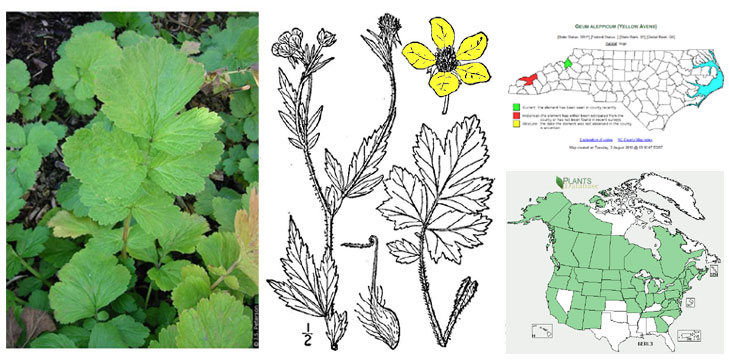

Habit of Geum aleppicum (Photo: Krings)

Inflorescence of Geum aleppicum (Photo: Krings)

Flower of Geum aleppicum on day of first opening (Photo: Krings). Note that all anthers are yellow.

Flower of Geum aleppicum on second day after opening (Photo: Krings). Note that some anthers are already turning darker in color.

Flower of Geum aleppicum on third day after opening (Photo: Krings). Note that some anthers are darker in color.

Flower of Geum aleppicum several days after opening (Photo: Krings). Note that some anthers are darker in color.

Fruits of Geum aleppicum (Photo: Krings).
Geum aleppicum (rare [State E, S1 G5]; bogs and boggy meadows; Mt)
8'. Petals white; fruiting tori bristly (only at base and tip in G. laciniatum)...9.
9. Pedicels puberulent (sometimes slightly hirsute); petals (3–) 4–7 (–7.5) mm long...G. canadense 
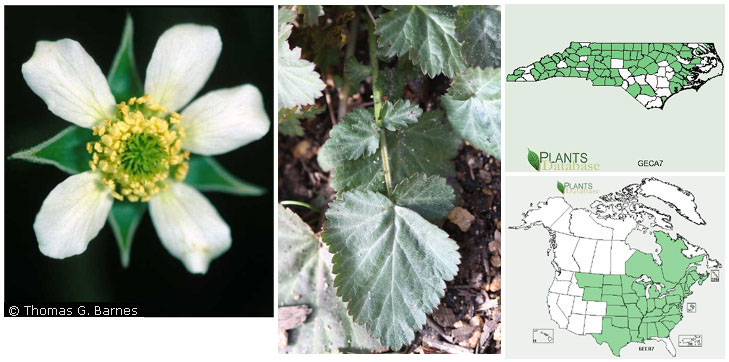

Stem of Geum canadense (Photo: Krings)

Leaf of Geum canadense (Photo: Krings)

Leaf of Geum canadense (Photo: Krings)

Stipules of Geum canadense (Photo: Krings)

Stipule of Geum canadense (Photo: Krings)

Flower of Geum canadense (Photo: Krings)

Styles of Geum canadense (Photo: Krings)
Geum canadense (common; moist to dry forests; Mt, Pd, CP)
9'. Pedicels densely hirsute (and puberulent); petals (2–) 2.5–4 (–5.5) mm long...G. laciniatum 
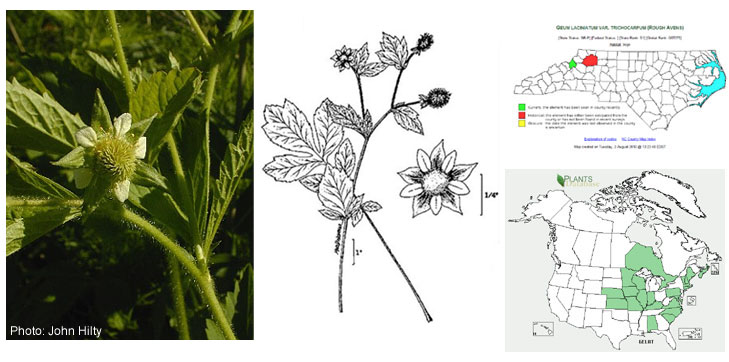 Geum laciniatum
Geum laciniatum (rare [State E, S1 G5]; bogs and boggy meadows; Mt)
Notes—Two varieties of Geum laciniatum are currently (as of Sep 2019) recognized by USDA PLANTS (var. laciniatum: achenes glabrous; var. trichocarpum: achenes pubescent with long, stiff trichomes):
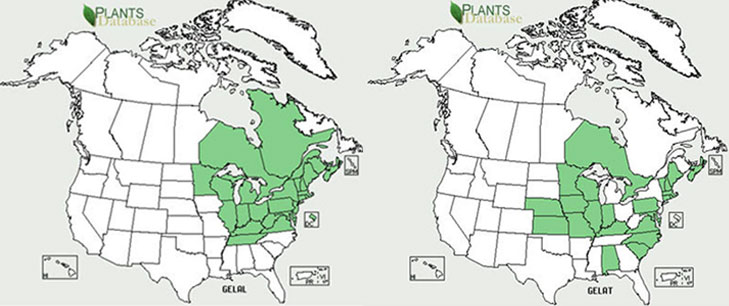
Figure. Distribution of the two putative varieties of Geum laciniatum fide PLANTS (2010): left, var. laciniatum; right, var. trichocarpum.
However, Weakley (2015) accepted only a single species with no varieties, noting that achene pubescence seems not to be correlated with any other trait.










